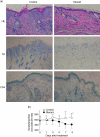Spontaneous scratching behaviour in DS-Nh mice as a possible model for pruritus in atopic dermatitis
- PMID: 16827890
- PMCID: PMC1782295
- DOI: 10.1111/j.1365-2567.2006.02365.x
Spontaneous scratching behaviour in DS-Nh mice as a possible model for pruritus in atopic dermatitis
Abstract
Itching is one of the major clinical symptoms in atopic dermatitis (AD) and complicates the management of this pathological condition. An animal model of AD-like pruritus would contribute to a better understanding of AD and could lead to the development of safe and effective antipruritic agents. DS non-hair (DS-Nh) mice raised under conventional conditions spontaneously develop pruritus, which is associated with a dermatitis similar to human AD. There is a significant positive correlation between disease severity and the period of scratching behaviour in DS-Nh mice. In the present study, we found that levels of histamine and nerve growth factor (NGF) in serum and/or skin tissue were higher in DS-Nh mice with AD-like dermatitis than in age-matched mice without dermatitis. The histopathological data indicated that nerve fibres extend into and mast cells infiltrate the surrounding area of the skin lesion. NGF production by XB-2 cells, which was derived from mouse keratinocytes, was enhanced by histamine via the H1 receptor. We also found that prolonged treatment with an H1-antagonist was effective against pruritus through depression of the production of NGF, which is thought to be generated by keratinocytes. We conclude that DS-Nh mice can serve as a suitable model for gaining a better understanding of pruritus in AD, and that prolonged treatment with an H1-antagonist may be beneficial in patients with AD-associated pruritus.
Figures







Similar articles
-
Quantitative analysis of nerve growth factor (NGF) in the atopic dermatitis and psoriasis horny layer and effect of treatment on NGF in atopic dermatitis.J Dermatol Sci. 2009 Jan;53(1):48-54. doi: 10.1016/j.jdermsci.2008.08.011. Epub 2008 Oct 14. J Dermatol Sci. 2009. PMID: 18922683
-
Synergetic effects of prednisolone and olopatadine on atopic dermatitis model of hairless mice.Pharmacology. 2010;85(5):286-94. doi: 10.1159/000297508. Epub 2010 May 4. Pharmacology. 2010. PMID: 20453552
-
Effect of loratadine on mouse models of atopic dermatitis associated pruritus.Int Immunopharmacol. 2005 Jul;5(7-8):1331-6. doi: 10.1016/j.intimp.2005.02.004. Epub 2005 Mar 9. Int Immunopharmacol. 2005. PMID: 15914337
-
Interleukin-31 and interleukin-31 receptor: New therapeutic targets for atopic dermatitis.Exp Dermatol. 2018 Apr;27(4):327-331. doi: 10.1111/exd.13533. Exp Dermatol. 2018. PMID: 29524262 Review.
-
Methods for preclinical assessment of antipruritic agents and itch mechanisms independent of mast-cell histamine.Biol Pharm Bull. 2015;38(5):635-44. doi: 10.1248/bpb.b15-00090. Biol Pharm Bull. 2015. PMID: 25947907 Review.
Cited by
-
Inhibition of temperature-sensitive TRPV3 channel by two natural isochlorogenic acid isomers for alleviation of dermatitis and chronic pruritus.Acta Pharm Sin B. 2022 Feb;12(2):723-734. doi: 10.1016/j.apsb.2021.08.002. Epub 2021 Aug 5. Acta Pharm Sin B. 2022. PMID: 35256942 Free PMC article.
-
DOE-Assisted Formulation, Optimization, and Characterization of Tioconazole-Loaded Transferosomal Hydrogel for the Effective Treatment of Atopic Dermatitis: In Vitro and In Vivo Evaluation.Gels. 2023 Apr 4;9(4):303. doi: 10.3390/gels9040303. Gels. 2023. PMID: 37102915 Free PMC article.
-
Atopic dermatitis: allergic dermatitis or neuroimmune dermatitis?An Bras Dermatol. 2016 Jul-Aug;91(4):479-88. doi: 10.1590/abd1806-4841.20164211. An Bras Dermatol. 2016. PMID: 27579744 Free PMC article. Review.
-
Site-Specific Transient Receptor Potential Channel Mechanisms and Their Characteristics for Targeted Chronic Itch Treatment.Biomolecules. 2024 Jan 15;14(1):107. doi: 10.3390/biom14010107. Biomolecules. 2024. PMID: 38254707 Free PMC article. Review.
-
Impact of T-cell receptor Vbeta haplotypes on the development of dermatitis in DS-Nh mice: synergistic production of interleukin-13 caused by staphylococcal enterotoxin C and peptide glycans from Staphylococcus aureus.Immunology. 2007 May;121(1):51-61. doi: 10.1111/j.1365-2567.2007.02536.x. Epub 2007 Feb 20. Immunology. 2007. PMID: 17313488 Free PMC article.
References
-
- Leung DY. Atopic dermatitis: New insight and opportunities for therapeutic intervention. J Allergy Clin Immunol. 2000;105:860–76. - PubMed
-
- Williams HC, Burney PG, Pembroke AC, Hay RJ. The U.K. Working Party's Diagnostic Criteria for atopic dermatitis. III. Independent hospital validation. Br J Dermatol. 1994;131:406–16. - PubMed
-
- Kimura T, Miyazawa H. The ‘butterfly’ sign in patients with atopic dermatitis. evidence for the role of scratching in the development of skin manifestations. J Am Acad Dermatol. 1989;21:579–80. - PubMed
-
- Wahlgren CF. Itch and atopic dermatitis: an overview. J Dermatol. 1999;26:770–9. - PubMed
-
- Koblenzer CS. Itching and the atopic skin. J Allergy Clin Immunol. 1999;104:S109–13. - PubMed
MeSH terms
Substances
LinkOut - more resources
Full Text Sources
Other Literature Sources
Medical
Molecular Biology Databases
Miscellaneous

